This page covers fish which live on the bottom (benthic), or swim just above it (benthopelagic). For pictures and information on deepsea pelagic fishes (which swim in the open water), go to the "Mesopelagic / Midwater" Page.
A. Oregon/California Subtidal, Bathyal and Abyssal
From 1) SUBTIDAL zone off Eureka, California: Continental shelf/Eel River site at about 510m-520m (with Lisa Levin, Scripps Inst. Oceanogr.);
2) Off Newport Oregon, on a) SubtidalL Continental shelf (Hydrate Ridge) at 600-900m (with Lisa Levin), b) BATHYAL continental slope (1800-2000m), and c) the ABYSSAL plain (2850m) (with Joe Siebenaller, LSU); and
3) From Subtidal, Bathyal Abyssal, California (500-3500m) (with Jeff Drazen, U. Hawai'i)
Click pictures for larger images.
*Pictures with "*" or "?" are species we haven't fully identified yet.
Thanks to Ruben Pohl (Austria) for tentative identifications of eelpouts and cuskeels, and for depth information on many species.
Some top Photos are from Alvin submersible or video frames from ROV Oceanic Explorer (off Newport, Oregon, and Eureka, Calif.)
Other Photos are from captured specimens (off Newport, Oregon, or Monterey, Calif.) |
| |
1. Chondrichthyes, Agnathans |
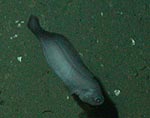 |
 |
 |
 |
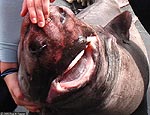 |
| Unidentified fish seen from Alvin, 600m |
Catshark* (ROV photo) |
Brown Catshark Apristurus brunneus (33-950 m) |
Pacific sleeper shark! and sleeper shark jaws
Somniosus pacificus
(0-2000 m) |
 |
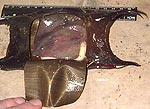 |
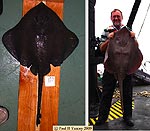 |
|
 |
White Skate and eggcase
Bathyraja spinosissima
(800-2938 m) |
Deepsea Skate
Bathyraja abyssicola
(362-2910 m) |
Chimaera seen from Alvin(600m) |
 |
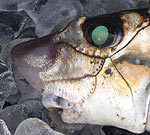 |
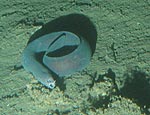 |
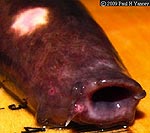 |
 |
Chimaera or spotted ratfish (relative of sharks)
Hydrolagus colliei (0-913m) |
Hagfish seen from Alvin |
Hagfish Eptatretus
(probably deani, depth
107-2743m, mainly 250-1200m). |
River Lamprey Lampetra ayresi (caught at 500m). |
| |
| Catshark: These are Chondrichthyans--fish with cartilaginous skeletons (a group that includes sharks, rays and skates, and chimaeras). The Monterey Bay Aquarium has a good photo of this shark, with information.
Sleeper sharks!: these seemingly sluggish sharks (hence their name) live mostly in the deep in temperate waters, but migrate to Alaskan waters where they come up to the surface and eat salmon. Their relatives in the Atlantic eat seals and even reindeer!
Skates: these soft-nosed cartilaginous fish are inhabitants of the continental slopes. Like the common skates of shallow waters, they are carnivores that rest on the bottom and swim with their "wings," and lay eggs in capsules (above) that look like a piece of algal detritus. Possibly the deepest-dwelling skate is Rajella bigelowi from the North Atlantic (300-4100m).
Chimaeras or ratfish: for information on these odd-looking relatives of sharks, see Chimaeras--the Neglected Chondrichthyans at the Biology of Sharks and Rays website
Hagfish: these are Agnathans--primitive fish lacking jaws. As common scavengers of the bathyal zone, they eat large carcasses, and coat them in a noxious slimy coat to ward off other scavengers. Their tough skins are harvested to make so-called "eelskin" bags and wallets! The Monterey Bay Aquarium has a good photo of another deep species, with information.
Lampreys are also Agnathans. These are like salmon: they migrate into freshwater rivers to spawn. At sea, they are parasites on larger fish including sharks. This is not a deep-sea fish but we caught one in a 500m trawl in 2009 off Monterey, Calif. |
| |
| 2. Osteichthyes--bony fish |
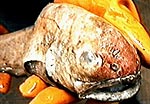 |
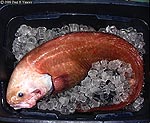 |
 |
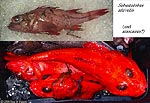 |
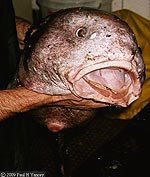 |
Cuskeel or Brotulid? *
Sciadonus pedicellaris?
(1847-4880m) |
Pudgy cuskeel
Spectrunculus grandis
(800-4300m) |
Shortspine thornyhead
Sebastolobus alascanus (17-1600m) |
Idiotfish or longspine thornyhead
Sebastolobus altivelis
(200-1760m) |
Blob sculpin
Psychrolutes phrictus
(550-1400m; possibly to 2800m) |
 |
 |
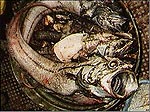 |
 |
 |
Dover Sole
Microstomus pacificus
(30-330 m) |
Rattail or popeye grenadier
Coryphaenoides
cinereus
(550-1800m mainly) |
Rattail or grenadier
Coryphaenoides spp;
one on the left has a large
parasite in its skin. See the MBARI site on rattails; scroll down there for parasite information. |
Giant grenadier
Albatrossia pectoralis
(500-1600m mainly)
(and Joe S. of LSU) |
Sablefish (ROV photo) |
 |
 |
 |
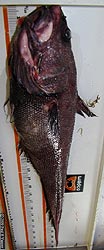 |
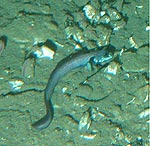 |
Sablefish Anoplopoma fimbria
(mainly 300-1400m; max 2740m) |
Pacific grenadier
Coryphaenoides acrolepis
(900-1300m mainly; 3700m max) |
Ghostly grenadier
Coryphaenoides leptolepis
(610-4000 m) |
Abyssal rattail/grenadier
C. armatus
(worldwide 282-5180m) |
Eelpouts seen from Alvin at 600 and 890m |
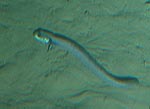 |
 |
 |
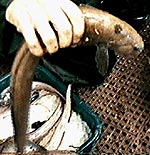 |
 |
| Eelpouts seen from Alvin at 600 and 890m |
Eelpouts: Lycenchelys sp.* (left);
Lycenchelys camchaticus or jordani?* (right) |
elpouts:
Deepwater slipskin? (right)*
Lycodapus endemoscotus?
(1900-2200m?)
Pachycara bulbiceps (left)
(2400-4800m) |
 |
 |
 |
 |
 |
Filamented rattail C.filifer (top) (1285-2904m); and
C. yaquinae (~3000-5800m) |
Finescale mora
Antimora microlepis
(175-3048 m) |
Two snailfish:
Careproctus melanurus
(89-2286m)
and C. gilberti
(73-886m) |
 |
 |
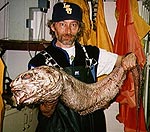 |
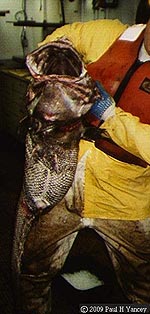 |
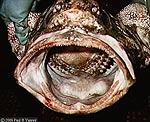 |
Eelpout
Pachycara gymninium
(1829-3225 m) |
Slickhead Alepocephalus tenebrosus
(46-5500m) |
Giant grenadier
Albatrossia pectoralis
(500-1600m mainly)
(and Joe S. of LSU) |
| |
|
|
|
|
Brotulid fish: these are fairly common deep fishes, with big heads and tapering tails (but are not closely related to rattails with similar body forms; see below). Deeper species often have small or degenerate eyes. Not much is known about them. The deepest known fish in the oceans are brotulids Abyssobrotula found in trenches at over 8000 m and thus in the Hadal or Hadopelagic zone. The record appears to be an Abyssobrotula galatheae at 8372m in the Puerto Rico trench (thanks to Ruben Pohl for this information).
Thornyhead fish (Scorpaenids): these two closely-related species have similar habitats, with the longspine tending to be deeper. A 1978 study by Siebenaller and Somero (cover story of Science) reported that the longspine has more pressure-resistant proteins than the shortspine, a landmark discovery of a protein adaptation to pressure in an animal. The shallower of these two species, the shortspine, has been targeted heavily by fisheries recently.
Blob sculpin: a flabby, loose-skinned fish that probably sits on the continental slopes waiting for prey. First discovered in the 1960s off California
Flatfish:
(Pleuronectids) like soles and halibut start out looking like normal fish larvae, then metamorphose into flat shape tiwh one side (either right or left) becoming the bottom, and eyes migrating to the top side. Dover soles make lots of mucus for protection.
Rattail or Grenadier fish (Macrourids): termed benthopelagic or demersal fish because they swim just above the bottom, these relatives of cod are the most common fish of bathyal and abyssal habitats. The deepest grenadier observed lives down to 6500m.
Rattails have huge heads, large eyes, and long tapered tails. They have swim bladders--which may be used to make sound as well as to float--and cruise slowly above the bottom searching for live animals and carcasses to eat. The Russians have been catching these fish for food for many years now, and their numbers are declining in their waters. For a recent article on such deep-sea fishing, see New Scientist, Nov. 8, 1997. See the MBARI site on rattails (Macrourid fish) for more information
Our lab studies how these fish adapt to high pressure. See the High Pressure page for details.
A swimming rattail can be seen in the recent movie "TITANIC" in the scenes filmed in the underwater wreck, which lies at about 4000m. Rattails at the Titanic are also described on the Discovery Channel's expedition there.
Sablefish: common carnivores; the target of some deepwater fisheries; may live to be 70 yrs old.
Snailfish (Liparids): relatives of the ones we caught were recently reported as the deepest living fish ever filmed alive (though not the deepest ever caught by net; see brotulids above).
Zoarcids or eelpouts: these eel-like fish are also poorly known in the deep; generally bottom-dwelling or benthopelagic. Some species are associated with hydrothermal vents, often seen swimming around giant tubeworms in videos of the vents. |